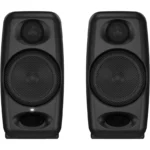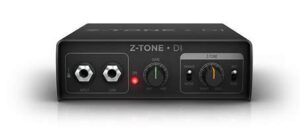
 IK Multimedia. Musicians First
IK Multimedia. Musicians First

Your instrument’s golden channel
USER MANUAL
Z-TONE DI
Thank you for purchasing Z-TONE DI.
Your package contains:
Z-TONE DI is an ultra-low noise, high bandwidth, and ultra-low distortion direct box, preamp and buffer, with variable gain and input impedance.
It provides transformer-based galvanically isolated balanced output and electronically buffered low impedance unbalanced output, as well as PURE and JFET input stages for total transparency or added harmonics.
In addition to being powered by a 9V battery, the Z-TONE DI can also run on phantom power provided by your mixing console.
Register your Z-TONE DI
By registering, you can access technical support, activate your warranty and receive free JamPoints™ which will be added to your account. JamPoints™ allows you to obtain discounts on future IK purchases! Registering also keeps you informed of all the latest software updates and IK products.
Register at: www.ikmultimedia.com/registration
Front panel
 Instrument input – 1/4” (6.35mm) jack type – Connect your instrument here (e.g., guitar).
Instrument input – 1/4” (6.35mm) jack type – Connect your instrument here (e.g., guitar).- LINK output – LINK connector is wired in parallel with the INPUT: the LINK connector can be used both as a direct unbalanced output of the INPUT signal. You can, for example, connect LINK with the input of an amplifier. Z-TONE input impedance control also affects LINK output.
- ON LED – this LED indicates that the unit is turned on. It will turn on when the input jack is inserted and the unit is powered either from a battery or 48V.
- GAIN control – adjusts the input gain: center for unity gain; -8dB when fully counterclockwise, +8dB when fully clockwise.
- PASSIVE/ACTIVE – Pick-Up selector – this selector allows you to match the type of pick-up installed on the connected instrument.
- Z-TONE™ – Variable impedance control – the front control named Z-TONE™ allows you to change the input impedance on the instrument input allowing for a unique possibility for tone shaping on your instruments.
- JFET/PURE – Preamp topology selector – this selector allows you to select two different preamp topologies for your connected instrument: JFET preamp type and Pure preamp type.
Rear panel
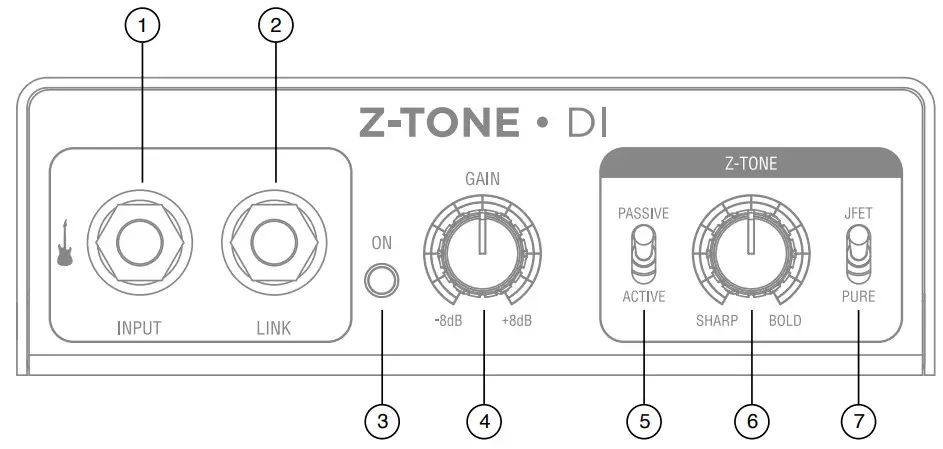
- 9V battery compartment. If the battery is installed and P48 phantom power is provided on the balanced out, the +48V will have priority over the battery.
- Unbalanced output – Electronically buffered, grounded unbalanced output.
- Balanced output – High-performance transformer-coupled balanced output with a ground lift option.
- GND LIFT – when the GND LIFT switch is depressed, the ground connection is interrupted.
- PAD -20dB – The attenuation button increases the operating range of the Z-TONE DI. By activating the PAD, the Z-TONE™ control will be bypassed.
Power up the Z-TONE DI
Z-TONE DI runs off a 9V battery for easy portability, but can also be powered by +48v phantom power from your mixer or interface to run longer sessions without worries. If the battery is installed and P48 phantom power is provided on the balanced out, the +48V will have priority over the battery.
The front ON LED will turn on when the input jack is inserted and the unit is powered either from battery or 48V.
Dedicated guitar features
JFET / PURE input
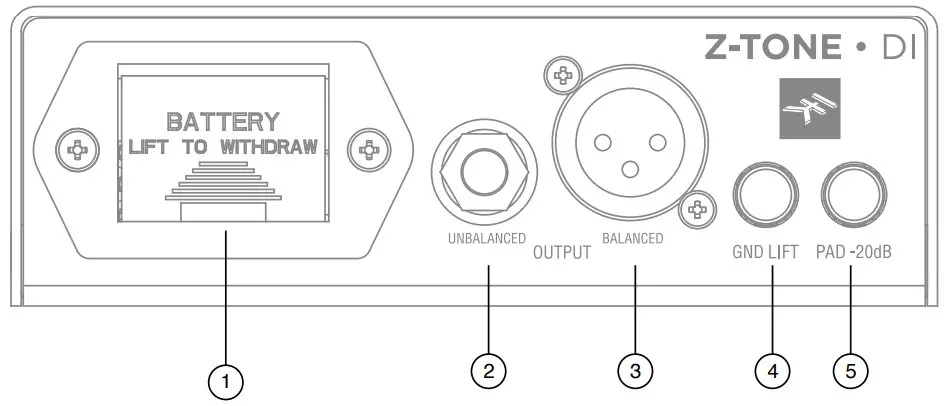
Thanks to the front panel selector it is possible to select two different preamp topologies for your connected instrument: JFET preamp type and Pure preamp type.
The discrete JFET (field-effect transistor) circuitry adds a tiny bit of color and harmonics to the signal, giving your instruments a bit of added warmth.
Pure circuitry results in a more linear response featuring the absolutely cleaner signal path possible, for best transparency and clarity.
Each amplifier topology offers complimentary sonic performance to the other, and both are widely used in professional recording and stage work. Note: this control only works when the Pickup selector is on the Passiveposition.
Pick-Up selector
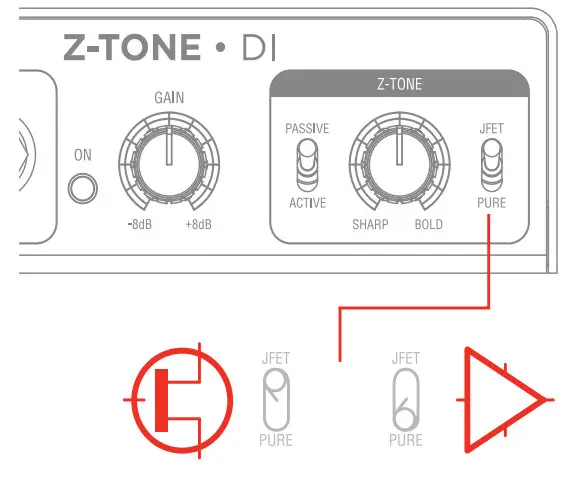
Z-TONE DI works perfectly with both Passive and Active guitar or bass pickups, having independent circuitry that suits perfectly both topologies. Passive electric guitar pickups exhibit significantly higher output impedance than the active counterpart, among other significant tone differences, but neither of the two is “better” or “worse” than the other: indeed they have different behaviors. To properly couple this diversity of guitar pickups in the most musically pleasing manner, Z-TONE DI offers a pickup selector that allows the artist to select between Active (when using an active pickup) and Passive (when using a passive pickup).
Variable impedance (Z-TONE™) control
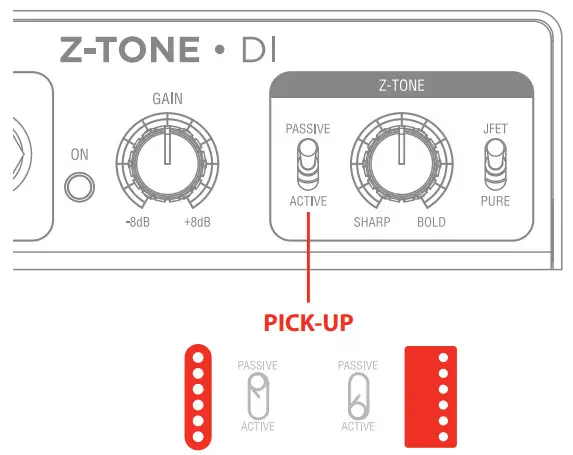
All passive pickups (being them single-coil, humbucker, split, etc..) have a certain sound character that is also determined by the loading impedance. The Z-TONE™ front control allows you to change the input impedance on the instrument input, therefore, allowing for a very creative way of shaping the tone of your instruments.
The beauty of this system is that it allows you to discover tonal shades from your instruments that you never heard before, by shaping the tone right at the source, within the pickups, instead of what is normally done with post-processing tools of any kind.
Feel free to experiment without rules with this knob! You will find your tone becomes generally more thick and bold by reducing the impedance (control is moved clockwise) and, on the other hand, more crisp and sharp when rotated counter-clockwise.
For example, if you find your high gain tones to be too harsh, try setting this control at mid position, and you’ll experience what the Z-TONE can magically do.
If you’re recording a bass (with passive pickups) and find it sounds a bit thin, try the same. The sound will immediately feel more bold, solid, and bigger.
The key here is experimentation! Feel free to check it out on your instruments, on various configurations, the possibilities are really endless.
Settings start from the highest impedance value (named “Sharp”) to the lowest impedance value (named “Bold”) The Z-TONE circuit only works with passive pickups of any kind.
Using it on active pickups will not provide any significant useful change to the sonics of the instrument.
Typical applications
Learn how to get your best guitar and bass tone using Z-TONE DI performing live on stage or recording in a pro recording studio or your home studio.
Home studio
High-end guitar/bass direct recording in a home studio

This setup allows you to record a DI guitar track at the highest possible quality into your DAW for further plug-in processing. With the addition of Z-TONE control, any audio interface can become the best audio interface for guitar and bass.
High-end guitar/bass amp+DI recording in a home studio
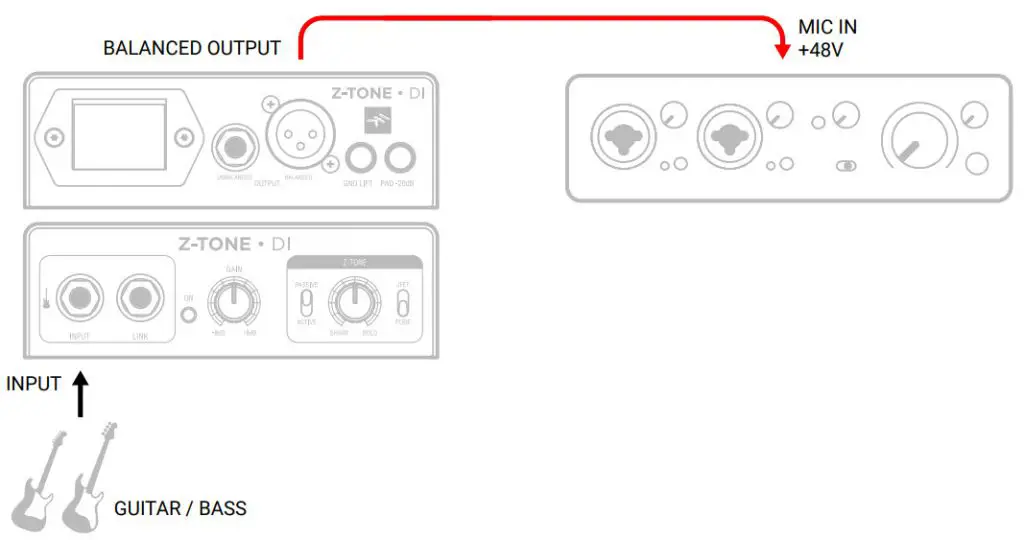
This setup allows for simultaneous recording of a DI guitar track and miked amp—at the highest possible quality—into your DAW for further plug-in processing. With the addition of Z-TONE control, your audio interface with 2 microphone inputs can become the best guitar and bass interface.
Professional studio
High-end guitar/bass direct recording in a pro studio
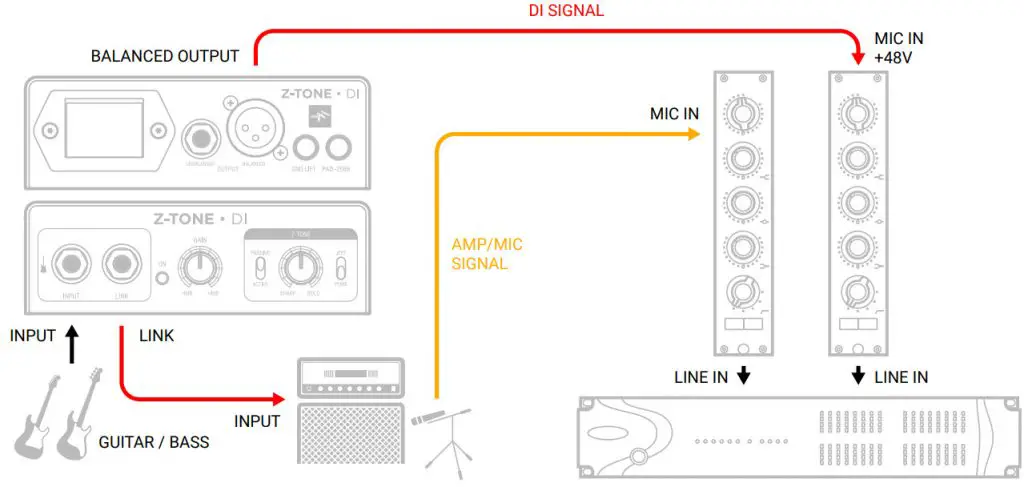
The setup below allows you to record a DI guitar track at the highest possible quality in your DAW for further plug-in processing. With the addition of Z-TONE control, you can still plug into your existing high-end modern or vintage mic preamps and capture amazing guitar or bass tone.
High-end guitar/bass amp+DI recording in a pro studio

The following setup allows for simultaneous recording of a DI guitar track and miked amp—at the highest possible quality—into your DAW for further plug-in processing. With the addition of Z-TONE control, you can still plug into your existing modern or vintage mic preamps and capture amazing guitar or bass tone.
Live
Live electric bass rig
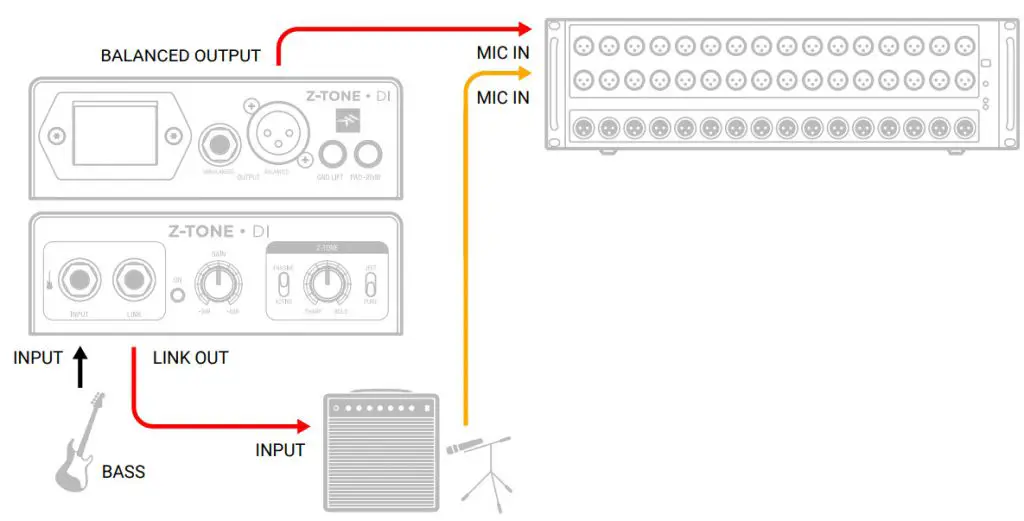
This setup is ideal for a live high-quality electric bass rig. The Z-TONE control will affect both the tone of the signal to the FOH (front of house) and the signal sent to your on-stage amplifier.
Live electric bass rig with pedalboard
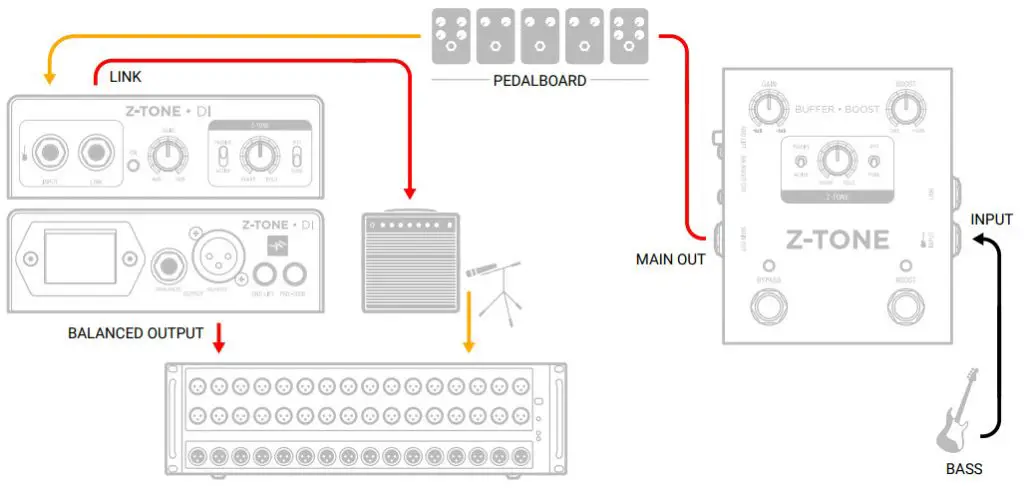
Z-TONE Buffer Boost is the ideal first pedal on your pedalboard. It buffers your guitar signal to drive pedals and amps with the best integrity and purity of tone. Z-TONE control will open a new palette of tones from your guitar or bass and the boost switch will add that edge for solos–with maximum level and minimum possible noise.
Here, Z-TONE DI is used to split the signal between FOH direct and to your amp.
Ground-loops elimination
Elimination of ground-loops with USB instruments

Connecting USB instruments to a computer and then to an audio interface at the same time can often cause a noisy ground loop. The galvanically insulated Z-TONE DI balanced output completely eliminates ground loop noise.
Elimination of ground loop noise using laptops or tablets onstage
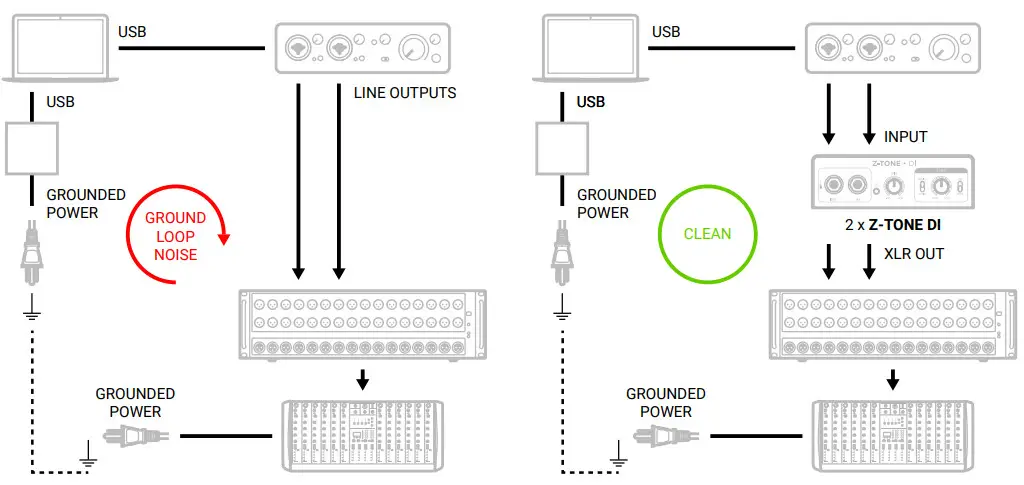
When connecting grounded computers or audio interfaces to a stage box or on-stage mixer, a noisy ground loop is likely. The galvanically insulated Z-TONE DI balanced output completely eliminates ground loop noise.
Specifications
Audio specs
I/O Gain: Unitary, from 1/4” input JACK to both 1/4” and XLR outputs when GAIN is at 0dB and Z-TONE at the SHARP position.
Gain Range: From -8dB to +8dB
Input impedance – Z-TONE set on PASSIVE mode: Variable from 1MΩ down to 2.2kΩ
Input impedance – Z-TONE set on ACTIVE mode: Approx 20kΩ
Output impedance, unbalanced out: 56Ω
Output impedance, balanced out: 600Ω
Max input level before clipping: +13dBm when powered by 48V phantom,+9dBm when powered by 9V battery
PAD: -20dB
Dynamic Range: better than 114dB(A) for both outputs, input gain at 0dB
Total Harmonic Distortion, balanced output, 1kHz, +4dBm input: 0.0033% (PURE), 0.2% (JFET)
Total Harmonic Distortion, unbalanced output, 1kHz, +4dBm input: 0.00055% (PURE), 0.2% (JFET)
Frequency response: from 5Hz to 30kHz -1dB
Phase deviation: 0° +/-10° from 20Hz to 20kHz
Power
Phantom power: +48V phantom on Balanced output. +48V phantom has priority over the installed battery.
Battery power: 9V
Current consumption from P48 phantom power source: 6.5mA
Warranty
For detail on your product’s warranty, please visit:
www.ikmultimedia.com/warranty
for the complete warranty policy.
Support and more info
www.ikmultimedia.com/support
www.ikmultimedia.com/products/ztonedi
Regulatory
 FCC statement
FCC statement
This device complies with Part 15.107 and 15.109 Class B of the FCC Rules CFR47:
October 2010.
Operation is subject to the following two conditions:
- This device may not cause harmful interference.
- This device must accept any interference received, including interference that may cause undesired operation.
Changes or modifications not expressly approved by the party responsible for compliance could void the user’s authority to operate the equipment.
USER’S MANUAL REVISION NOTE:
v1.0 (2020/02/19): Initial Release
Z-TONE DI, AmpliTube, and SampleTank® are trademarks property of IK Multimedia Production Srl. All other product names and images, trademarks and artists’ names are the property of their respective owners, which are in no way associated or affiliated with IK Multimedia. iPad, iPhone, iPod touch Mac and Mac logo are trademarks of Apple Computer, Inc., registered in the U.S. and other
countries. Lightning is a trademark of Apple Inc. App Store is a service mark of Apple Inc.
